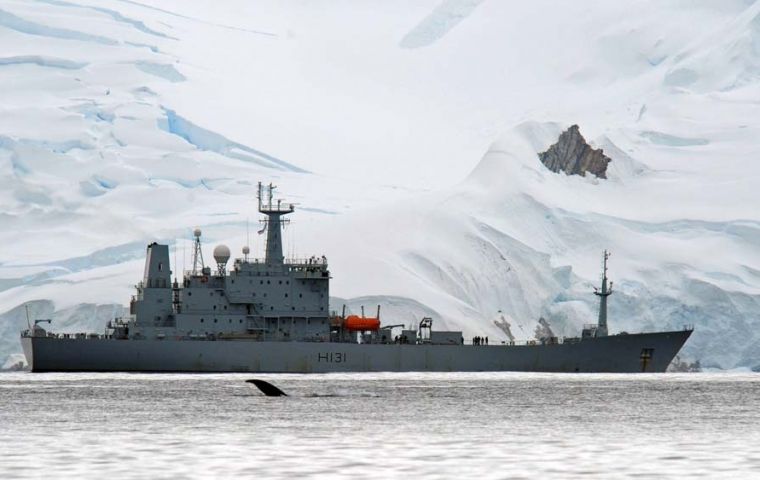MercoPress. South Atlantic News Agency
HMS Scott on Ice Patrol and Antarctic sea deep water survey mapping
 The Royal Navy survey vessel is replacing the ill-fated HMS Endurance
The Royal Navy survey vessel is replacing the ill-fated HMS Endurance The Royal Navy ocean survey ship HMS Scott has returned to Antarctica for Ice patrol duties that include scientific research in coordination with the UK Hydrographic Office and the British Antarctic Survey.
“Carrying out this ice patrol is a privilege and a change from our usual tasking of ocean survey. Scott has the flexibility to let us carry out a range of activities that have been carried out by previous Royal Navy ships here” said Scott’s Commanding Officer, Commander George Tabeart.
“Safety of life is a paramount concern in these remote waters, so our survey work will ensure that tourists can safely visit the pristine environment and witness the abundance of wildlife in Antarctica”, added Commander Tabeart.
HMS Scott is the Royal Navy’s Ocean Survey Vessel and is one of the largest in the fleet at 13,500 tons. She left Devonport in Plymouth before Christmas and her crew has endured the worst of the Southern Ocean on the way to Antarctica. Winds have blasted at more than 60 knots and there have been 20-feet waves and storm conditions.
Besides protecting Britain’s scientific interests HMS Scott will also be involved in patrolling duties in South Georgia, South Sandwich and South Shetland Islands.
The tasks include inspecting fishing vessels, visiting Antarctic research stations and enforcing the tough environmental measures of the Antarctic Treaty. This helps to ensure that the wilderness of Antarctica is maintained for generations to come.
HMS Scott will also continue her deep water survey work, mapping the Antarctic Seas to ensure safe passage for the plethora of cruise ships that are now visiting the region.
The vessel’s sonar is capable of surveying the deepest oceans in continuous lines of up to 400 miles in length.
The full ship’s crew is 78; however, the crew rotation system means 52 are onboard at any one time during a standard 35-day operational cycle and the remainder of the crew take leave. By operating in this way the ship can be at sea for 307 days a year.
HMS Scott is named after Captain Robert Scott. 2011 marks the centenary of Captain Scott’s fateful expedition to the frozen continent of Antarctic.
After sailing from Cardiff on 15 June 1910 onboard Terra Nova, the expedition reached the pole but sadly on 29 March 1912, Captain Scott and his four man party perished as they tried to return to safety.



Top Comments
Disclaimer & comment rules-

-

-

Read all commentsIt is very good that she has been sent to carry out what she does best. It would be a shame if she ended up as part of any future cuts, I believe if the British pull out, others will readily take over and claim all sorts of things,
Feb 24th, 2011 - 09:18 pm 0the Antarctica is a place of peace as well as research, but other scrupulous countries are ready and waiting to exploit this beautiful place .
“ ... Besides protecting Britain’s scientific interests HMS Scott will also be involved in patrolling duties in South Georgia, South Sandwich and South Shetland Islands ...”
Feb 25th, 2011 - 01:06 am 0For all the defence cuts, this is still a priority ! Of course ;-)
“ ... helps to ensure that the wilderness of Antarctica is maintained for generations to come ..... ”
I wonder how many generations ?
As the south Atlantic is the gateway to the world, Britain would be very stupid and ignorant if she gave it up.
Feb 25th, 2011 - 12:13 pm 0I think the British will be around for centuries yet.
Commenting for this story is now closed.
If you have a Facebook account, become a fan and comment on our Facebook Page!